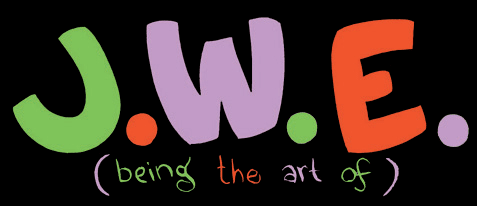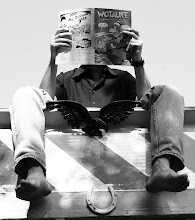This covert, make-believe concern, aptly named A Very Limited Recording Company, was born in response to five young men, each already an integral part of the city’s cultural landscape (such lofty positions best left unspoken), who saw fit to dispense with traditional song-making concerns and forge ahead, blindly, into their own, uncharted madness, churning out wholly improvised “songs” at the touch of a recording button, like some secret dada wing of the famous Brill Building. Calling themselves Our Musical Situation, they produced some eleven full-lengths, plus numerous re-packagings and side-project recordings (all of which shall be featured in further installments of this pictorial history). The only rule was “record it all, and edit later”, a credo that gave rise to such chestnuts as Cheers to the Creepers, Daddy’s Hole, and the entirely inscrutable Teabag Joe, songs that still warm the hearts of imaginary music listeners everywhere.
The full, dense, eight-year history of AVLRC has yet to be written, suffice to say that this is merely an introductory glimpse at the earliest manifestations of its rapidly-mushrooming catalog.
Having been in the right place at the right time, I was enlisted into this great act of impracticality, quickly finding myself the sole agent of the company’s art department, turning out all CD packaging, promotional materials and the official AVLRC newsletter. Later, as the swell of product outgrew my capacity to aptly furbish all with suitable visual flourish, another willing sole was drawn into the enterprise, but these earliest images that follow are all the result of my keen interest in helping define the imaginary notion, something I still hold dear to a fractious heart, even as the dogging demands of reality skulk ever closer to my door.
I hope you enjoy these highlights, culled from that pioneering bridge of summers, spanning 2001 to 2002, a time during which I chose to portray the five members of OMS as plastic-headed dolls, something that, in retrospect, seems quite prescient, the music industry itself having become a less-tangible thing in the intervening years, the faces of its ever-rotating crop of cash stars growing more unreal, and frustratingly static, by the day.
For a more-detailed look at the art packaging of each of the first six OMS records, simply click here.
And, please note, all frivolity aside, I do design and accommodate actual musical product: records, posters, t-shirts, etc. Feel free to inquire if you are an interested party. As you can see from the gallery that follows, I utilize a wide variety of means to capture the character of the musical project in question.
Happy second birthday, OMS!
The boys celebrate their second year by winning the coveted Tea Kettle Award, an assuring sign of recognition from an imaginary industry. At right is band manager, Clarence Credence, brother of AVLRC CEO, the late Donovan Credence (yes, the imaginary are capable of escaping the mortal coil too).
Unused version of the cover photo to the sixth OMS album, Sgt. Special’s Lonely Organ Band Sessions.
From the same album, an unused view of a historic OMS performance in a Detroit club, circa 1972. As the band prospered, so did its ability to age backwards. A nifty tack of the imaginary, that.
The cover to the very first OMS record, The Softball Shorts Sessions, recorded June 30, 2001, and an obvious homage to A Hard Day’s Night, The Beatles’ third UK album.
OMS guitarist and singer, Eric, from the blur-themed Softball Shorts photo sessions. Note that this head lasted only one record, a better Eric soon to be found.
OMS drummer, Chris, from the same sessions.
OMS bassist, Kevin, equally blurred.
OMS guitarist, Kurt, but a blur.
OMS singer and instrumental clown, Jem, as blurry as they come.
The cover to the band’s second full-length, The Thirty-Five Candles Sessions, recorded on August 11, 2001, in celebration of bassist Kevin’s thirty-fifth birthday.
An unused, alternate cover to The Thirty-Five Candles Sessions.
Another unused image from the second record.
The intended cover to an aborted early side-project, The Old Growth EP, featuring Kevin, Jem and Eric (who would later become known as The Dreaming Boys – sans beards).
A view of the photo shoot for the above cover, revealing something of my fabrication process.
Pages three and four of the multi-paged booklet that accompanied the third OMS record, the decidedly conceptual The Jeffica Sessions, the band’s strange telling of the “scar-crossed” tale of a transgendered life.
The inside cover to The White Room Sessions, the fourth LP, recorded November 17th, 2001.
An alternate version of the cover photo to The White Room Sessions.
Another unused image from White Room, revealing the set I fashioned for this shoot.
The cover to the fifth record, The Old Pedal Effect Sessions, recorded October 27, 2001. (Five releases in six months, not bad.)
An unused image of the band, as a bowling team, with an unidentified gent at left, rumored to be Gustav Salubrius, renowned AVLRC producer.
The cover to Sgt. Special’s Lonely Organ Band Sessions, recorded December 1st and 8th, 2001. This was to be the final act of the band’s doll-faced era.
A variation on the back card art to Sgt. Special’s, the boys sporting their most handsome country and western gear.
Another shot from the Detroit club session, capturing the crowd in motion.
Finally, the OMS boys, in all their finery, posing for a press luncheon.




























